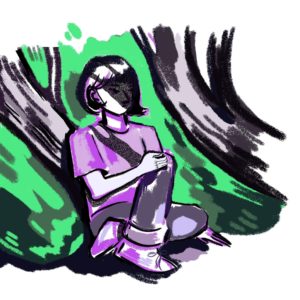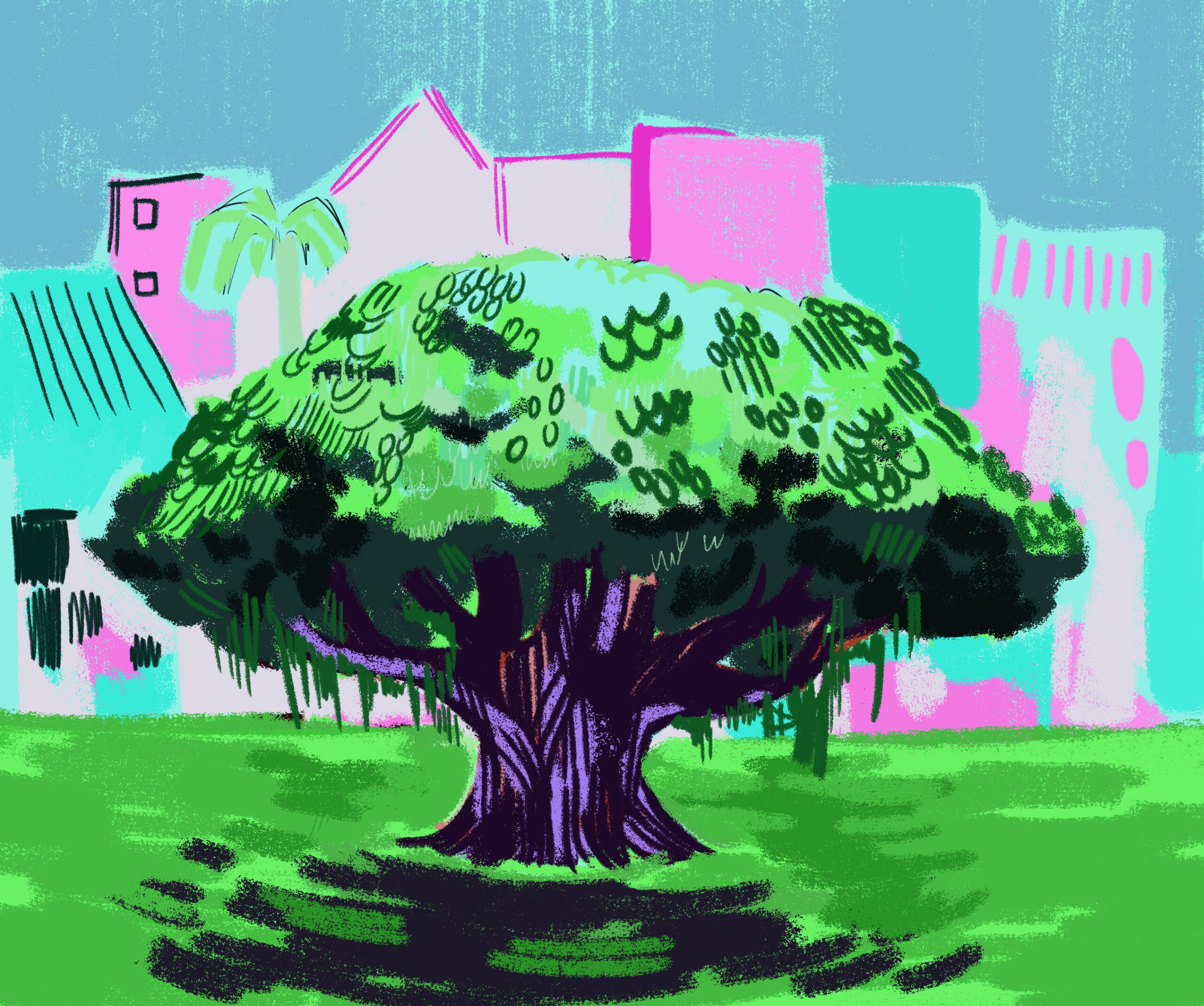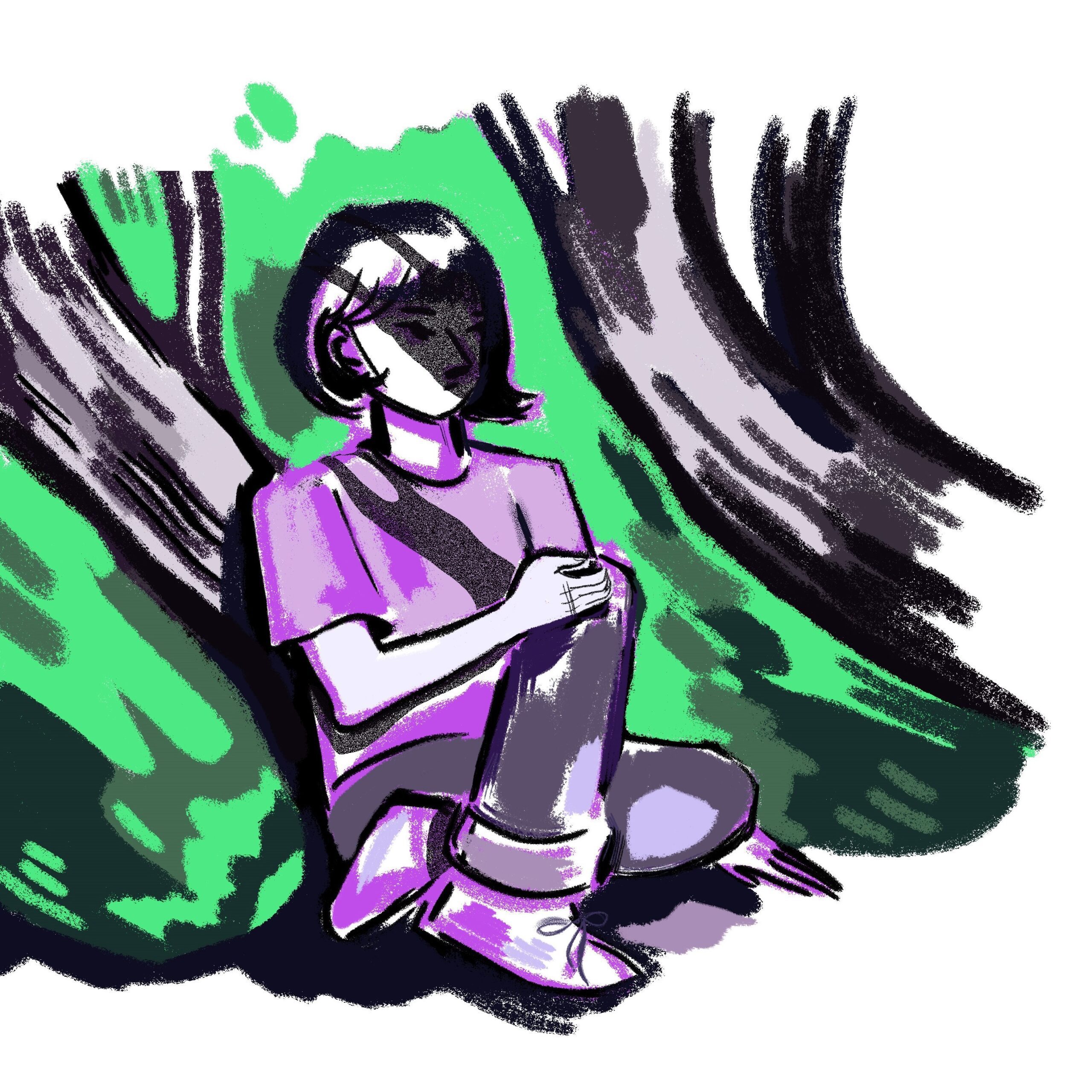
When I was little, my mother called me her water baby. When I wasn’t running around the deck of a sailboat, I was diving to the bottom of our pool, searching for plastic rings and silver coins. From the bow of the boat, I watched dolphins play in our wake, and I mirrored their playful spirit as I splashed around in rivers, bathtubs, oceans.
Splashing in the shallow reaches of the bay, my mind was full of mermaid folklore. With a snorkel mask pressed to my face, I searched for the swish of a tail, listened for their siren song in the waving reeds. They were elusive, but I was sure they existed.
When we first moved to Miami from New Orleans, my father was constantly jumping out of the car to collect leaves from exotic trees he had never seen before. He couldn’t get over the different types of bark—some colorful and smooth, others prickly with spines—and he had us rub our hands against tree trunks to feel the difference. He loved the banyans best, the way they stood guard over Coral Way like hulking giants, strands of hairy roots hanging down from their oafish limbs.
My sister Gaby and I loved them, too. We had our favorites in the neighborhood—the best trees for climbing and playing hide and seek. One morning, after an angry storm, my mother took us for a slow drive around the neighborhood to witness the damage. We were children then, our tiny legs disappearing into yellow rain boots, and our eyes widened as we pointed at felled trees, upturned mailboxes, broken street lamps. Mami brought the car to a stop next to our favorite park.
There, blocking the road, was a banyan tree toppled over like a tongue-tied mountain. This had been one of our favorites. Gaby and I stumbled out of the car, unbelieving that such a massive, sturdy being could be brought to its knees by a night of high winds. We had spent entire afternoons lost inside this sprawling cathedral of leaves and limbs, imaging the magical creatures that might inhabit it once everyone went home for dinner.
We joined the other children climbing its trunk, using its branches as balance beams. The roots were exposed, a tangled web of wooden tendrils, like a lattice of laced veins.
Banyan trees may be enormous, full of nooks perfect for hiding and daydreaming, but their roots are shallow, lifting up sidewalks and destroying sewer systems. Although they grow all over our city, shading our avenues and neighborhoods, they are like us—immigrants to this land—brought over by seafaring travelers lifetimes ago.
To truly know a land is to become it—to embody its storms in your bones, taste its dark soil beneath your nails, know the tangled history of the people who walked before you.
Like almost everyone living in Miami, neither of my parents were born on American soil; Caribbean energia and European practicality mingle in my veins. But somehow, we’ve all landed here—on a spit of land that is more water than it is earth. A collection of first-generation immigrants and descendants of political refugees colliding on the southern ledge of this strange peninsula.
I am jealous of those who can trace their lineage back for generations to a single region. I imagine all the knowledge they must carry in their bones: the imprint of fox tracks, the insight of medicinal flowers and edible roots, the wisdom of serpents and dust-winged creatures.
In Cuba, my mother’s family was part of the landed gentry: landowners, landlords. Their printing press business placed them firmly in the upper class. They had property, pastures, livestock—all of which they left behind when they fled the country.
It has been said that, when Columbus landed in Cuba in 1492, he spoke these words: “Esta es la tierra mas hermosa que ojos humanos vieron.”
Cuba is the most beautiful land that human eyes have ever seen.
I saw Cuba once. I was on a plane, and I held my breath the whole time, memorizing the curves of the coast, the kiss of cloud-covered mountaintops. This is the land that saw my mother’s birth, my grandmother’s carefree smile before my family’s lives were snatched from them.
And yet, before Cuba, my family’s homeland was across the Atlantic, in the emerald hills of Galicia and the sun-soaked Canary Islands. With each generation, a new place to sink our feet into the soil.
This is the legacy that has been passed down to us by our ancestors, an inheritance of transplantation. Even the winged ones follow unseen paths in the sky.
Then again, is this a curse—or a gift? Are we rootless, or simply free?
What is the opposite of land? What is the opposite of landing?
We’ve landed in a place where water reigns, a place that is as low as can be and still be called land. With the smallest difference between its highest and lowest point, Florida is the flattest state in the country. Although the region has been relatively stable throughout geologic history, without any major bending or fracturing, seesawing sea levels have brought superficial changes to the Florida plateau. There have been times when the Florida peninsula was much wider than it is today, and other times when it disappeared altogether. Even when the land was exposed, much of it was still something between land and water: swamp muck, cypress domes, a slow-moving river of grass.
The indigenous peoples that inhabited this peninsula before the white man knew this. Their communities were not permanent establishments, and they lived on the land with the understanding that the waters would reclaim it often, during king tides and hurricanes.
The land I was raised on is part of the Atlantic Coastal Ridge, a region of layered rock formed over time beneath turbulent water. As the sea level has risen and fallen over the last few million years, these layers of loose sand grains bonded together, creating soft, calcareous oolite that is easily pulverized and transformed into cement. This limestone bedrock makes for meager soils, unlike anything our Caribbean ancestors have ever known. Our ancestors came from islands where the soil is black as night— composted volcanic ash—where plants and food can’t help but grow wild. But this land is different with its soil the color of faded sunflowers, frail dirt that sprouts high rises and highways in effortless abundance.
For so many of us, South Florida has been a refuge. We’ve landed here from many corners of the world, seeking sanctuary, a life raft to hold onto in the wake of displacement. Do not think that our rootlessness translates to a lack of love for this land. Quite to the contrary. We belong nowhere and we have decided to belong here. We feel this belonging with a fierceness.
Land has become a sacred word for me, always on my tongue. I whisper it like a mantra.
Land.
Land.
I speak the word as if just saying the syllable will send the message up to the heavens.
I do my research, squinting at elevation maps and studying predictions for sea level rise. I read articles about South Florida with titles like “Come Hell or High Water,” “Treading Water,” “Doomed to Drown,” and “Goodbye Miami.” I try my best to decipher dense documents about government mitigation strategies, water salinization, and groundwater depletion. What I learn: Florida’s mean elevation is around six feet above sea level. High tide is normally around three feet, and storm surges increase this by four or five feet. Sea level is projected to rise anywhere between one and seven feet in the next hundred years, but probably closer to the higher end since we are outpacing current projections. Some scientists say that a mere six-inch rise will cause saltwater to breach the current barriers in place.
A friend of mine, an environmental ecologist, tells me that we are already surpassing all predictions for climate change. When I ask her about Florida’s fate, her response is four letters. GTFO. Get the fuck out.
I have seen the streets of downtown Miami fill with water after a storm. King tides steal miles from our coastline. The swamps we so foolishly believed we could keep at bay will return with a vengeance—the only question is when. In my own neighborhood, a heavy rain is liable to flood the area for days; the water has nowhere to go.
It is the expectation of permanence that hurts us the most.
South Florida. We seek refuge on land with an expiration date. Soon we will be thrown out to sea again, to find sanctuary elsewhere. How will it happen? I wonder. Will a super-storm drown out the city, sending hordes of Floridians northward, desperate for higher ground? Or will the change happen so slowly that the city has time to keep up with the destruction, fortifying storm walls and installing complex pump systems? What to make of the sinkholes, or the saltwater intrusion that has already begun to creep into the water table we rely on for fresh drinking water?
I am not afraid of water. I was raised on the sea. I spent my childhood on my father’s sailboat, watching the sun disappear into the ocean night after night. The sound of wind slapping the halyards against the mast brings me peace, and I am comforted by the waves lapping against the hull. And yet, I dream of solid ground, someplace to lodge my anchor so that I may still soar. Within me, in my ribcage and my marrow, I feel the constant push and pull between movement and stillness, between land and sea, between rootedness and wandering.
On new moons, I sit in a circle of women around a blazing fire, praying for the healing of mother earth and her sacred waters. We are magicians of seeds and soil. We are apprentices of the elements, humbled by the whims and furies of the seasons. Ours is a shared dream: to have a piece of tierra to call our very own, so that the generations to come won’t be as rootless as we are.
The opposite of land is water. The opposite of landing is flight.
Once, when I was in between housing leases and the ferocity of Miami had started to wear on me, its pulsing heartbeat rarely quieted, I set up my one-person tent in my parents’ backyard. My family thought I was crazy—told me I could sleep in my old twin bed, in my childhood room with walls painted sunflower yellow and the ceiling cornflower blue. I tried to explain to them that this was where I needed to be: close to the earth, to feel her heartbeat.
For months, I fell asleep to the sounds of a nocturnal symphony—croaking toads and chirping crickets—and I slept better than I had in years. Before bed, I’d walk the land with bare feet, grateful for the solid ground beneath me. In the morning, with eyes squinting into the morning sun, I prayed to the seven directions for guidance, prayed for healing of the earth, our mother, pachamamita.
Often, I thought about my ancestors. Yes, they were landowners, but did they feel the same shared heartbeat as I do with madre tierra, mother earth? Did they ever rest their foreheads on the earth and ask for forgiveness?
I’ve since packed up my tent and moved on to the next chapter of my life. But I still can’t stop staring at the elevation map my friend sent me. It has a toggle for sea level rise; you can move it up—one feet, two feet, three feet, six—and watch South Florida go blue. The water creeps in from all sides—the ocean to the east, the Everglades to the west. I train my eyes to find the speck of land that is my parents’ backyard. Even with a seven-foot sea level rise, our property seems to stay dry. Unfortunately, our neighborhood will have become an island by then, the rest of the city erased by the sea.
***
Rumpus original art by Aubrey Nolan.







